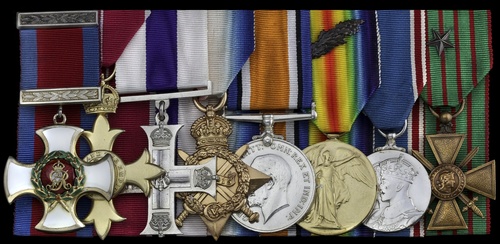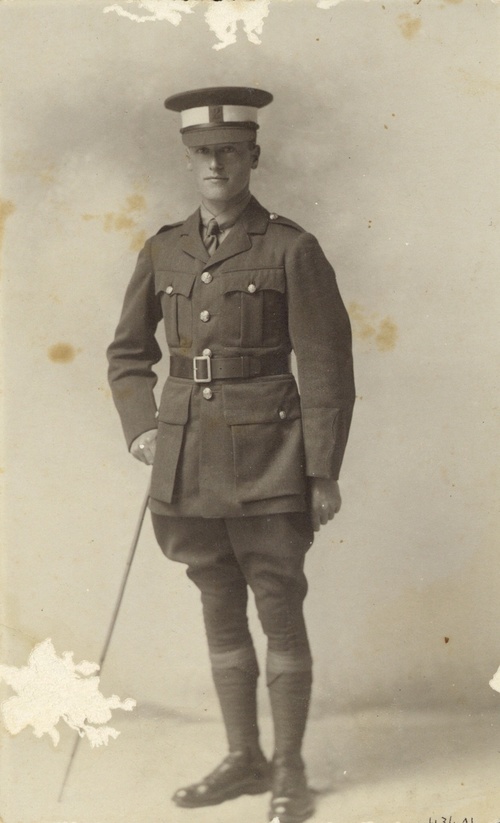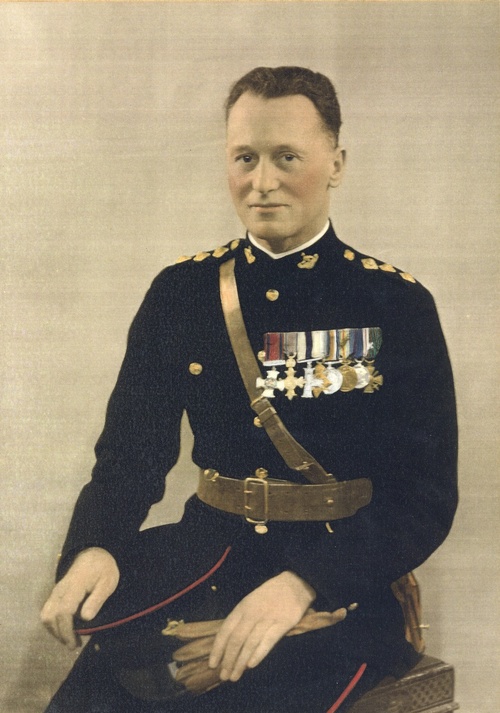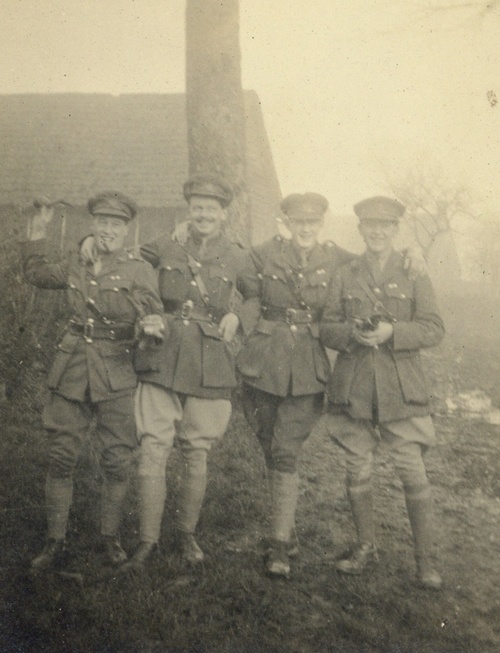Auction: 19002 - Orders, Decorations and Medals
Lot: 373
'Early on the 25th Villers-Bretonneux was again in our hands. In this vital success the 7th Battalion played a notable part. The Battalion was largely composed of nineteen-year-old boys who had been rushed out from England to replace losses, and splendidly they behaved in conditions which would have tried the most experienced.
By the time the Battalion had made some progress towards Cachy, all the Company Commanders had fallen. Only two Officers were left, 2nd Lieutenants E. J. Scott and W. Tysoe, and Scott was wounded and taken prisoner early on the 25th when the Battalion was almost surrounded.
The defence of the ground won, on which the security of the right flank of the counter-attack depended, then devolved on Tysoe, who made C-S-M. Kirby his Second-in-Command; and these two encouraged their young soldiers by their fine example.
A demand for surrender, accompanied by the statement that the Bedfords were surrounded by two Divisions, was contemptuously refused and at dusk Tysoe finished the day gloriously counter-attacking a German attempt to take his position. At dawn on the 26th he was relieved by the Moroccan Division, having won the D.S.O.'
The 16th Foot - A History of the Bedfordshire and Hertfordshire Regiment, refers
An outstanding and well documented 'Villers-Bretonneux 1918' D.S.O., 'Northern Rhodesia Regiment - Edward VIII issue' O.B.E., 'Le Cateau 1918' M.C., 'St. Quentin 1918' Croix de Guerre group of eight awarded to Major W. Tysoe, Northern Rhodesia Regiment, late Lieutenant, Bedfordshire Regiment and Private, Northamptonshire Regiment, who gallantly commanded his Battalion when every other officer had been lost; he again displayed brilliant individual leadership on two further occasions
Tysoe subsequently served in North Russia as a Lewis Gun officer with the 46th Battalion, Royal Fusiliers before emigrating to Rhodesia, where he served for 20 years in the British South Africa Police and the Northern Rhodesia Regiment
Distinguished Service Order, G.V.R., silver-gilt and enamel; The Most Excellent Order of the British Empire, O.B.E. (Military) Officer's breast Badge, silver-gilt, hallmarks for London 1928; Military Cross, G.V.R.; 1914-15 Star (12362 Pte. W. Tysoe. North'n. R.); British War and Victory Medals, with M.I.D. oak leaf (Lieut. W. Tysoe), second with officially re-impressed naming; Coronation 1937; France, Republic, Croix de Guerre, reverse dated '1914-17' and with Bronze Star upon riband, mounted for display, lacquered, traces of adhesives to back of awards, very fine (8)
D.S.O. London Gazette 13 September 1918:
'For conspicuous gallantry and devotion to duty. He showed great skill and ability as the only company officer left, in organising and consolidating the line after a successful counter-attack; and when next day the enemy again attacked he drove them back, inflicting heavy casualties on them. He showed fine dash and leadership.'
O.B.E. London Gazette 23 June 1936 (Captain, Northern Rhodesia Regiment).
M.C. London Gazette 8 March 1919:
'During the operations north-east of Le Cateau on the 22nd/23rd October, 1918, he continually showed utter disregard for his own personal safety. On the night previous to the attack he laid out the forming-up tapes in spite of constant machine-gun fire at close range. Subsequently, on the 23rd, he visited and ascertained the positions of all the posts held by the battalion after the attack, and his fearless devotion to duty was of great value in gaining information as to the position of front line troops.'
Croix de Guerre London Gazette 6 July 1919. The citation, signed by General Brecard, Commanding Officer of the 1st Mounted Infantry Division, states:
'On 25 March 1918, on the occasion of the German offensive at St. Quentin sur Noyon, he participated in a counter-attack near the village of Baboeuf which instantly checked the German advance. In the evening of the same day he helped to cover the movements of the 1st Mounted Infantry Division which had crossed the River Oise at the bridge of Varennes, displaying both outstanding soldierly qualities and comradeship in action.'
William Tysoe was born on 24 June 1893 at St. Lawrence, Northampton, the son of a 'shoe laster'. A shoe hand by trade, he enlisted in the Northamptonshire Regiment on 24 August 1914 and served in France from 31 May 1915 before being commissioned 2nd Lieutenant in the Bedfordshire Regiment 28 November 1917.
Into the action - time to shine
Tysoe returned to France on 28 January 1918, and by the conclusion of the year had proven himself an exceptional individual. Serving with the 7th Battalion, he assisted the French in March prior to his finest hour at Villers-Brettoneux in late April. On 24 April a German counter-attack had taken allied ground, across a front which was thick with mud and littered with machine-gun nests and concealed snipers. Not only this, but the 7th Battalion had recently been re-supplied with a draft of fresh soldiers, most of whom under the age of twenty and no doubt a number of them underage. Brigade Headquarters issued the order to advance on the Villers-Brettoneux to Aubercourt Road to the Acting Commanding Officer and Adjutant, Captain H. C. Browning. The advance began in darkness, thier objectives some 2,000 yards ahead of them. German artillery opened a fierce barrage, twice scoring direct hits on Battalion Headquarters. In the exchange which followed, heavy casualties were suffered by both sides - indeed some 57 names are recorded on the Commonwealth War Graves Commission listing for this date.
By this stage only two officers remained standing. As such, Tysoe and fellow 2nd Lieutenant Scott divided the front in two. Tysoe took the left flank, with the Australians on his outer, whilst Scott took the right flank, with the Kents on his outer. Scott in fact found he was alone to the right, allowing a flanking by the German troops. In attempting to report this fact back to Headquarters, Scott and his Batman were wounded and eventually captured.
Tysoe was now alone and in command. Instead of making a withdrawal, he formed up the remnants of the Battalion, forming them into groups of platoon strength, each under the command of an N.C.O.
At 8a.m. on 25 April, the enemy sent a party to meet Tysoe under a white flag, ordering his surrender to avoid further bloodshed. Tysoe politely refused and sent the party - now under blindfold - back to the German lines under escort. A second party came towards his lines but again he refused to discuss a surrender. By lunchtime and with Australian support Tysoe made a successful attack and captured Bois de l'Abbe. Shells now rained down on his positions and by dusk it was clear a German counter-attack was soon to come. Indeed a fierce attack came, forcing Tysoe to lead his trusty men by compass bearing for a withdrawal at the west end of the village. He was duly awarded an immediate D.S.O. from the hands of King George V at Buckingham Palace who, upon pinning the award to his chest, commented to the 2nd Lieutenant, 'You're very young!'
After a short rest at home, Tysoe was again in the thick of the action at Le Cateau in October 1918, in an action which resulted in the capture of 100 prisoners, 3 guns, 3 trench mortars and 100 machine-guns for the Battalion. He was awarded an immediate M.C. and gained a 'mention' before War's end (London Gazette 27 December 1918, refers).
North Russia & North Rhodesia
Attached - and subsequently transferred to - the 46th Battalion, Royal Fusiliers, Tysoe would serve in North Russia from May-October 1919 as a Lewis Gun officer, having been promoted Lieutenant on 28 May. He served in Jackson's Brigade on the North Dvina and was present in the Dvina Offensive on 10 August, in what was the largest battle fought by British troops during the Russian Intervention.
Tysoe was subsequently discharged on 3 January 1920 and enlisted in the British South Africa Police as a Trooper (No. 2240) on 11 April at Cape Town. His 'gongs' quickly attracted attention in early parades and he was in fact banned from wearing his awards until the War Office could verify his entitlement. Confirmation granted, he transferred to the Northern Rhodesia Police on 1 January 1921 in the rank of 2nd Lieutenant.
Having remained in the Police until April 1932, by which point he had risen to Captain, Tysoe was transferred to the Northern Rhodesian Regiment. His combat experience and coolness under fire was particularly useful during the riots of 1935, when he commanded a detachment of native troops called to assist in the town of Luanshya. Confronting a mob armed with machetes, spears and clubs, who had gathered by the Time Office, he calmly faced down the rioters. In the melee, a nervous trooper accidentally fired a round which passed a few inches above his C.O.'s head. Tysoe didn't flinch and the crowd realised discretion was the better part of valour. Having given evidence at the Official Inquest, Tysoe was awarded the O.B.E., a scarce award in the period of Edward VIII and is understood to have commanded the Coronation Contingent (Medal). Retiring as a Major, he resided in Salisbury and died in Saint Anne's Hospital on 29 June 1988.
An article entitled An outstanding soldier was published in Medal News, August 2006.
Sold together with his sword and a large original archive, comprising:
(i)
A hallmarked silver prize Medal engraved 'A.T.N. Div. Cross Country C'ship France 1918'
(ii)
Army Book 439, with entries in pencil, together with Discharge Certificate upon commission.
(iii)
Bestowal document for the D.S.O., together with 4th Army HQ certificate of award, Statutes and Army Order including the award.
(iv)
O.B.E. bestowal document, glazed and framed, signed 'Edward R.I.'.
(v)
4th Army HQ certificate for the M.C., together with Army Order including the award.
(vi)
Mention in despatches certificate in the name of 'T./2nd Lt. W. Tysoe, D.S.O., 7th Bn. Bedfordshire Regiment'.
(vii)
Citation for the Croix de Guerre, with the translation.
(viii)
Certificate for the 1937 Coronation Medal in the name 'Captain William Tysoe'.
(ix)
His own copy of the photograph album 46th Bn. Royal Fusiliers, Sadleir-Jackson's Bde., North Russia, May-October 1919, with ink inscription to inside 'W. Tysoe Lt.'.
(x)
An assortment of original paperwork related to his military service in Rhodesia and his civilian life.
(xi)
Original photographs of the recipient in uniform, together with mixed buttons and two cap Badges.
For the recipient's miniature dress medals, please see Lot 416.
Subject to 20% VAT on Buyer’s Premium. For more information please view Terms and Conditions for Buyers.
Sold for
£2,800
Starting price
£2100











